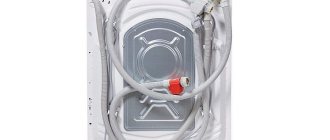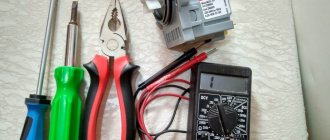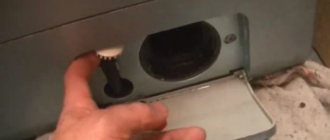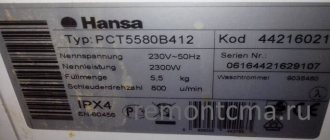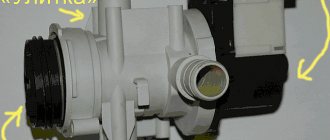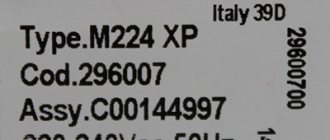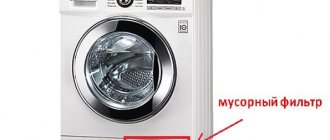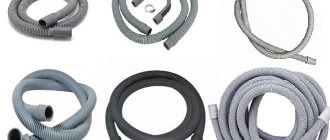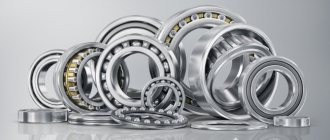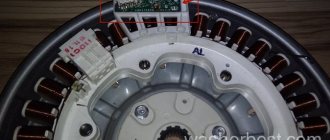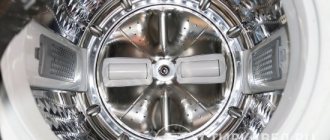A worn out or clogged pipe can cause serious problems. The automatic machine will simply refuse to work normally - it will not be able to fill the tanks with water or, on the contrary, drain the waste liquid into the sewer. Typically, this situation ends with the equipment freezing and the corresponding fault code being displayed on the display. You can replace the washing machine pipe yourself, without the help of a technician. To do this, you need to find out which hose is damaged. Let's figure out where the tubes are located and what functions they are responsible for.
Where are the pipes located?
The design of modern washing machines is similar. Any machine, regardless of the brand, has filler and drain pipes, as well as a dispenser hose. Three pipes work harmoniously, ensuring water circulation in the system. Let's figure out what the function of each element is.
The filler pipe connects the inlet valve and the powder receiver of the automatic machine. Water passes through it very quickly, enters the cuvette, where it combines with the detergent. Afterwards, the soap liquid flows through the dispenser hose into the washing machine tank. When it becomes necessary to remove waste water from the tank, the drain pipe comes to the rescue. It is through this that the liquid flows into the sewer, passing further through a garbage filter and a drainage hose.
Any of the three pipes of the machine may become leaky or clogged, as a result of which the normal operation of the washing machine will be disrupted.
The new SMA models have very durable and elastic pipes. However, over time they begin to harden and may crack and leak. In the pipe connecting the detergent cuvette and the tank, deposits from poorly soluble powders can collect and settle. The granules quickly petrify, interfering with the free “movement” of water.
The drain pipe is the most vulnerable. It is in it that all the debris contained in waste water is collected, and these are threads, hair, lint, sand, etc. Also, objects forgotten in clothing pockets can get stuck inside the hose: coins, keys, hairpins, toothpicks. Sometimes it becomes clogged with a sock that has fallen from the tank into the drainage system.
To understand which pipe needs to be changed, you need to monitor the operation of the washing machine. When water flows poorly into the tank or does not fill at all, you will have to inspect the inlet hose and dispenser tube. These same elements should be paid attention to if, immediately after starting the cycle, the machine begins to leak. You need to “sin” the drain pipe if the machine cannot remove waste water from the tank. You will also have to inspect it when a leak appears just after the drain starts. Let's figure out how to do the work with your own hands, where to start.
The dispenser is clogged or damaged during washing
If the water leak is concentrated in the area of the dispenser, a special retractable container into which powder is poured and products (stain remover, bleach, conditioner) are poured, after turning off the machine, you need to remove the dispenser, check its integrity and thoroughly clean it.
A sure sign that the cause of the leak lies precisely in the dispenser is the appearance of drops at the moment the wash starts, when the wash occurs, especially if you have recently begun to notice that the powder is not completely washed out of the container and some of it remains. This can happen because:
- The powder does not dissolve quickly enough and clogs the grate with its particles, making it difficult for further penetration of products and liquids into the drum;
- The sediment could be due to dirty water or impurities contained in it;
- Due to too much pressure.
After thoroughly cleaning the dispenser, as well as reducing the pressure (to do this, slightly tighten the supply tap), you can try to start the wash again. If the measures taken did not help, and the washing machine still leaks, it means that the damage is much more serious and you need to make repairs by contacting a specialist
Turn off the machine and clean the filter
It doesn’t matter which pipe needs to be changed, in any case, you can’t do without disassembling the machine body. Before starting work, be sure to turn off the power to the washing machine and close the shut-off valve responsible for the water supply. It is also important to drain the remaining fluid from the system, to do this:
- prepare a shallow container;
- cover the floor around the machine with dry rags;
- get to the garbage filter. On front cameras it is located in the lower right corner. To gain access to the plug, you need to either remove the false panel or open the technical hatch, this depends on the model of the washing machine;
- tilt the machine back, place a basin under the housing in the area where the filter is located;
- unscrew the plug half a turn, collect the flowing water into a container;
- remove the spiral from the hole, wait until all the liquid has poured out.
Here it is better to immediately clean the filter, rinse it in warm soapy water, and remove dirt deposits from the walls of the hole. Now you can proceed directly to the repair. You can inspect the filler pipe and dispenser hose by removing the top cover of the housing. To check the drain tube, you will have to lay the machine on its side.
Useful tips
In order for all systems to operate smoothly, it is recommended to regularly maintain them and correctly place the water intake and drainage hoses. They are located in such a way as to eliminate bends along the length, leading to damage to the element and leaks. Particular attention is paid to the drain hose - it is placed above a certain mark, which is indicated in the instruction manual. It is believed that the hose is not placed above the top point of the body of the unit for washing clothes.
For areas with threaded connections, grease should be used, which increases the service life of these areas. Make sure that there is no moisture in the threads, which can cause corrosion and damage metal elements.
It is recommended to clean the filter installed on the inlet from time to time. During operation, this is where the most dirt and various debris accumulate, which contributes to the ball sticking in the pipe. By removing such blockages, you increase the life of your washing machine.
If you do not have enough experience in performing plumbing work or do not have the necessary knowledge, then it is not recommended to independently connect the washing machine to the water pipe.
Incorrect actions can cause pressure loss in the system, water leakage, or damage to the washing machine.
Dispenser pipe
Having noticed that clean water is collecting under the body of the machine, first of all you should inspect the dispenser pipe. To check the element, you need to remove the top cover of the washing machine body.
The dispenser pipe is located in the left corner; it connects the inlet valve and the powder receptacle.
It's quite difficult to miss the hose. It is secured on both sides with clamps. You can make sure that the dispenser pipe is working properly:
- Use pliers to loosen the clamps;
- slide the clamps to the center of the pipe. You need to work with clamps carefully; they will be useful for later securing the hose;
- first pull the tube off the inlet valve, then from the outlet of the detergent tray;
- inspect the pipe for cracks and make sure there are no blockages inside.
When everything is in order, all that remains is to rinse the dispenser hose under running warm water and put it back. It is advisable to clean it with a bottle brush. If you find cracks in the rubber, purchase a new pipe that matches the model of your washing machine. Secure the entire hose in place with clamps. The part will also have to be replaced if the previously soft tube has hardened and feels “oaky” to the touch.
Why change the drain hose?
The part is changed in several cases:
- The corrugated part of the tube is damaged and there is a leak;
- A lot of debris has accumulated inside, it is not possible to clean it;
- The length of the original spare part included with the machine is not suitable, it is too short or long for the room in which the device is installed.
Repairing the tube if damaged or trying to clear the blockage actually makes no sense. The surface of the part is sealed. If a leak develops, it will not be possible to close it securely. Sooner or later, under the influence of water and household chemicals, it will appear again. The cost of hoses is low, on average they cost 100-150 rubles, replacement is easy.
If the leak is within the pipe, and at the place where the hose is attached to the sewer, it is better to call a plumber. Reliable fastening to the sewer drain is necessary so that in the room where the machine is installed there are no puddles from a leaky joint.
Water supply pipe leaking
On some washing machine models, for example LG, it is easy to remove the water supply pipe. To do this, you need to remove the top cover, loosen the clamps and dismantle the hose. However, sometimes it is difficult to get to the handset; you have to remove the front panel of the machine. The algorithm of actions will be as follows:
- turn off the power to the machine;
- turn off the water supply tap;
- remove the top cover by unscrewing the screws securing it;
- pull out the powder receptacle;
- unscrew the control panel fasteners;
- unhook the “tidy” and place it on top of the washing machine;
- remove the lower false panel by releasing the latches;
- pull out the outer collar of the hatch cuff. To do this, you need to use a screwdriver to pick up the latch and remove the “ring”;
- tuck the rubber seal inside the drum;
- unscrew the 2 bolts securing the hatch locking device;
- remove the front panel of the front camera housing.
The water supply hose runs from the dispenser to the tank. To remove the pipe:
- remove the fixing clamps located at both ends of the hose;
- Unhook the tube first from the cuvette exit, then from the tank.
Next, it remains to carefully inspect the element. If you notice damage, you will have to buy and install a new pipe. If the hose is clogged, clean it with a long, thin brush or simply replace the part.
Why should you contact our company?
The owners cannot always cope with this task, especially if the path to it is difficult to access. In these cases, there is a risk of damage to the device or its owner will spend enough time on simple work. Our company’s specialists will quickly help you solve the problem.
- We arrive quickly.
- The technician quickly determines the cause of the problem and easily finds a safe way to remove the pipes.
- All work is done in your home.
- Our specialists will arrive at a time convenient for you; they work not only on weekdays, but also on weekends.
- We offer reasonable prices and guarantee the work performed.
We repair washing machines in Fryazino, and also provide high-quality repairs of washing machines in Khimki and other cities in the Moscow region.
Connections between tank and pump
Most often, washing machine owners are faced with the task of changing the drain pipe. This is a rather vulnerable part through which tens of liters of soapy, contaminated water pass with each wash. It's no wonder why the hose is the first to wear out.
The drain pipe through the bottom is being replaced, so you need to carefully lay the automatic machine on its side.
Some washing machines have an open bottom, so you can immediately notice the required tube only by placing the machine in a horizontal position. If the machine has a tray, you need to unscrew the screws and remove it. The drain pipe is connected to three elements at once: a tank, a pump and a pressure sampling hose.
To remove the pipe, you need to deal with the clamps at all three points and pull the hose to the side. Inspect the rubber corrugation - if it is intact, clean the part with a brush, rinse under running water and put it back in place. If you find cracks, replace the element immediately. If the old hose is intact but very dirty, soaking it in water for two hours with the addition of citric acid can help. For two liters of liquid you will need only 100 grams of lemon juice. After the procedure, the pipe must be rinsed under the tap and put back in place.
It is up to everyone to prevent clogging of pipes. It is better to immediately install a deep cleaning filter in front of the entrance to the machine - then water will flow into the system without any impurities. It is also important to purchase only high-quality detergents so that they dissolve completely and do not settle inside the hoses. You also need to inspect the pockets before loading things into the drum and do not forget about the need for preventative cleaning of the drain filter (once every six months).
Interesting:
- Washing machine connection - review
- How to Replace Dishwasher Fill and Drain Hose
- Bosch dishwasher errors
- Error codes for AEG washing machines
- Error F04 in a Siemens washing machine
- How to drain water from an Indesit washing machine?
1 reader comment
- 12/20/2020 at 09:59
Anonymous:
The LG washing machine washes but does not spin. Tries to spin the drum and stops. The pump is constantly running. Could this be due to the heating element?
Answer
Reason 5. Faulty oil seal
If the washing machine leaks during the spin cycle, most likely the seal or bearings have become unusable. The oil seal is made of rubber; it connects the two parts of the drum. A sure sign that the part has become unusable is the characteristic sounds of grinding during the spin cycle when the washing machine is leaking.
To replace the oil seal or replace the lubricant, you will have to disassemble the machine. You can entrust such repairs to professionals or do it yourself.
What does damage cause?
The most common cause is engine overheating; failure will occur in a very short period of time. As a result of overheating, the cylinder block becomes deformed, cracks may appear and the piston may become deformed.
But it is much worse when the piston is completely deformed and makes a hole in the cylinder block. Such a breakdown usually leads to a complete replacement of the damaged engine with a new unit.
Checking work
After replacing or cleaning the pipes, it is imperative to carry out a test washing cycle without laundry to make sure there are no leaks or unusual sounds. To do this, run a short wash cycle with a spin at minimum speed. If the washing machine performs washing normally without delays or sudden stops, and normally draws and drains water without leaks, then the pipes are installed correctly.
If a small leak or delay is detected at any stage of washing, you need to re-disassemble and install the pipes.
Preparatory process
To replace the hose, it is necessary to disassemble the equipment by disconnecting the part from the pump. It is more convenient to first remove the cover from the machine by performing the following sequence of actions:
- Unscrew the screws on the back wall of the device.
- Slide the cover back.
- When the panel comes out of the grooves, remove it and set it aside.
Depending on access to the drain hose for machines from different manufacturers, different options for further actions can be distinguished. Let's look at the main ones: the drain product is located in the front, side or rear of the structure.
How to remove the back panel of a washing machine
How do you know what needs to be replaced?
Modern units have three categories of pipes:
If one of these elements becomes inoperative, further operation of the equipment is impossible. The causes of malfunctions include scale, blockages, physical damage, and poor quality detergents.
Washing machine repairs are best left to professionals.
We present to you our unique catalog of private masters and service centers - BigWash.ru
Select your city and artist in the filter: by rating, reviews, price!
Visible signs of pipe wear are:
- leakage during washing and spinning;
- water is slowly poured into the tank or drained after the wash is completed due to the fact that the diameter of the pipe is reduced due to scale and deposits;
- the presence of mechanical damage, cracks and holes caused by small parts.
The new pipes are flexible and durable. They harden and crack with use, especially in hard water conditions. If you notice that the pipe does not bend, but cracks when you try to bend it, replace it immediately.
Location of the drain hose base on the front panel
This option is used by such manufacturers of home appliances as Bosch, Siemens. To replace the drain hose of the washing machine, remove the front plastic surface. To do this, move the bottom panel to a distance of about 5-6 cm and unfasten the connector with wires from the module locking device. Then we slide the panel towards us and set it aside.
When access to the drain hose is open, remove the part by loosening the clamp and removing the fixing elements with a screwdriver. We replace the part of the machine with a new one, performing the steps in the opposite order. At the end, do not forget to check the tightness of the connection of the parts to the pump, and whether there are any kinks in the hose.
Preparation
To clean or replace pipes, you must carefully prepare the unit:
- close the water supply valve;
- disconnect the device from the power supply, water supply and sewerage systems, disconnect all hoses;
- prepare a rag and a container to drain the remaining water;
- remove the powder container;
- at the bottom under the front panel, unscrew the drain filter, drain the remaining water through the emergency hose;
Since you have already unscrewed the filter, clean it of debris and contaminants.
- move the unit so as to provide free access to the rear and side panels;
- tilt and carefully place the washing machine on its side.
The preparatory stage for the renovation has been completed. These measures are carried out to ensure ease of repair and complete removal of remaining water from the tank. The water is drained to avoid it getting on the electronic control module. You should stock up on tools and spare parts.
Washing machine repairs are best left to professionals.
We present to you our unique catalog of private masters and service centers - BigWash.ru
Select your city and artist in the filter: by rating, reviews, price!
